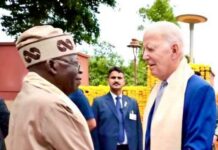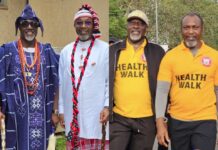Why Nigeria Needs Moral Re-Armament Now, By Martins Oloja
POLITICS DIGEST – I have been reflecting on what we should do to escape from the brink that a former United States envoy to Nigeria, John Campbell predicted in his strange (2010/2013) book, ‘Nigeria: Dancing on the Brink’. I have come to the conclusion that what we need after all, is not a strong political leader. We don’t need orators the iconic Benjamin Franklin calls “great talkers, little doers” too. We don’t need any candidate with overrated integrity. We don’t need prominent planners for enlightened self-interest anymore. As I noted last week, there is indeed a ‘crisis of character’ in Africa’s most populous nation. I just read a classic on whether something is actually wrong with being black. It was my pleasure reading a conclusion in Matthew Ashimolowo’s (2007) book, “What is wrong with being black? Celebrating our heritage, confronting our challenges”, that nothing is basically wrong with the black race. I think we should stop pontificating and ask for direction in wisdom that touched off some provisions in NEEDs 1 document: “need for national re-orientation” at the beginning of this democracy in 1999. The Obasanjo administration’s National Planning Commission (NPC) then launched the NEEDs document, which contained ‘national re-orientation’ as part of strategy to renew our minds for nation building.
We need a movement for national reorientation now! I mean we need ‘Moral Re-Armament’ now!
Why do I say this now, of all our needs? The level of indiscipline, lawlessness, collapse of values, morality, etc has been too high. The depth of impunity and abuse of immunity by the ‘execu-thieves’ has been intolerable. The way we celebrate wealth without work has been insufferable. Despite all the noise in Abuja about war on corruption, the growth rate of ‘state thieves’ has been unbearable. What of celebration of mediocrity at all levels where the worst rule the best and the brightest? How do we tame the rampaging public enemy No. I called ‘the rule of man’ rather than ‘the rule of law’? It has been so bad that the judiciary has taken over the electoral process of our democracy and has continued to redefine our electoral justice system. This has been strangely so because even the internal democracy structure in the political party system has collapsed. There is no conflict resolution mechanism anywhere. The politicians do not respect even the rules of engagement in their parties. What is worse, even the President can summon the ruling party’s chieftains to the State House and arbitrarily announce dissolution of all the party structures and announce an interim party executive, all alone.
Dictatorship is still growing in the ‘Federal Republic of the Nigerian Army’, as General Chris Ali has finely put it. Where do we go from the debt burden the present authorities in Abuja have been celebrating?
Let’s do some exploration of history on this Moral Re-Armament (MRA) option.
According to ‘Initiatives of Change International’, the study of network movements has grown from the 1970s and onwards. Important researchers as Nye and Kaiser have shown how transnational groups and movements can have both a broad and profound influence, and Nye’s works on the concept of “soft power” are important. This soft power stands in opposition to the “hard” power of oil and tanks – it includes culture, ideas, religion and worldviews, and it often by-passes the route via governments and military machines. Coca Cola, Ibsen and the idea of democracy are thus introduced as power factors in the historical analysis, and this soft power can be great.
Some modern scholars are wondering why the Moral Re-Armament movement is largely unknown both among historians and the general population. This has several reasons, but the size and influence of the movement in its glory years from the 1930s to the 1950s suggests that it deserves a bigger role in historical research than it has received. In the light of works on soft power and transnational networks, the movement is an ideal research subject, since it is a classical transnational network.
The American Frank Buchman started his movement after a religious breakthrough in England in 1908. He did not want to start a formal movement, but rather revitalise the classical Christian belief and practice, and his thoughts therefore spread from man to man. In the 1920s the ideas were brought to British elite universities, and the movement’s first name The Oxford Group came into use. The name Moral Re-Armament (MRA) was used from 1938.
Buchman took a radical approach, because he wanted to “remake the world”.
The solution was supposedly simple: Clean up all that in you which is in conflict with Christian belief and mirror yourself in The Oxford Group’s four absolutes: love, purity, honesty and selflessness. Open yourself up to divine guidance and share your sins with someone you trust, and through this you will find a healthy and lasting freedom. In short: “Sin is the disease, Christ is the cure, the result is a miracle.”
Read Also:
Buchman had a great political talent, and The Oxford Group operated from the start as an informal network. Both Buchman himself and his central people had a remarkable ability to get access to elite circles and to put themselves on the map, and the list of key people having contact with the movement in the 1930s and 1940s is astonishing. In the United States, Buchman had contact with Henry Ford, Thomas Edison, the Rockefeller family and President Roosevelt, and in England with leading evangelical thinkers like Wright and Streeter. In addition he had contact with European royalty, he met Gandhi, and when the movement came to Norway in 1934 it was after long contact between Buchman and C.J. Hambro, Vice President of the Norwegian Parliament.
Hambro and Norway is a good example of The Oxford Group’s work. In the letters between Buchman and Hambro early in the 1930’s, Buchman reveals himself as the tactician you have to be if you want influence, and the gain Buchman got from Hambro was mutual. Buchman gave Hambro access to elite circles in the States while Hambro worked on securing important people like Arne Fjellbu, Sem Sæland and Sigmund Mowinkel for the upcoming Group visit to Norway. When the movement came to Norway, it created great waves – Egil Elseth calls it “nothing less than the great religion sensation of the 1930s”. The publicity was great and many believed that Norway had been definitively changed.
That such a small group could make so much of a stir shows that Hambro and Buchman had made solid preparations. The fact that leading cultural personalities like the writer Ronald Fangen so openly joined this kind of American layman’s teaching was given considerable attention.
With the implementation of the new name Moral Re-Armament in 1938, the movement did a course correction with regard to methods and ideology. Anders Jarlert writes in his book on the movement that it in the second half of the 1930s, it changed its focus from persons to large structures, and MRA after World War Two presented itself with a solid belief in itself as carrier of “democratic ideology”. This was a political turn, and with this new way of thinking the MRA did its biggest networking achievement ever.
The two World Wars had shown that Europe had a German Problem, and MRA was determined to stop the errors of the last post-war years from repeating themselves. The post- war depression, that in 1945 was even worse than in 1918, and the resulting spiritual vacuum had to be filled with something good, if Europe was not once more to be thrown into disaster. The movement therefore set Germany as its number one goal, and the work was done through its broad and powerful network.
This work was twofold. First of all the movement bought a fashionable hotel in Caux in Switzerland and equipped it as conference centre, and second of all it sent groups of its people into Germany. The work in other words went both ways. The ideas were to be brought to Germany and the Germans were to be brought to the ideas in Caux, and both were made possible through the movement’s contacts. Key MRA-people had meetings with George Marshall, Bob Murphy and Lucius Clay, and these gave the green light for the MRA-groups moving into Germany and for the Germans to travel to Switzerland. These Germans were some of the very first Germans to be allowed to leave their country after the war.
In Germany, the movement assigned special significance to the Ruhr area, since communism was a looming danger, and in Caux it worked for reconciliation between Germany and France. Through its contacts it made sure that large parts of the first generation of post–war German leaders got to visit Caux, and it also made sure that they met Frenchmen. Immediately after the War this was radical, the Germans not being welcome anywhere in Europe, and least of all by the French. In addition, it was an important goal to kindle a new democratic spirit in the German visitors, who had failed so massively in their previous attempt at democracy. The work had support from the very top, and both Konrad Adenauer and Robert Schuman became warm and lifelong supporters of MRA.
The Palace hotel in Caux is a very good example of a network node in a transnational network. The movement gathered an astonishing collection of well-known and important personalities in its conferences, and Caux therefore worked as a sort of think tank and unofficial meeting place where people could gather under an umbrella of reconciliation. The work had a great effect; Lucius Clay, Konrad Adenauer and several key Germans confirm this. Paul Hoffman, the American administrator of the Marshall-help, put is thus: “You are giving the world the ideological equivalent of the Marshall Plan.”
MRA’s work shows that transnational networks have influence. Realists often deny this as not being proven, but that is the nature of the case. Conscience, the transfer of ideas and informal influence are always harder to document than economic factors, but they are equally real and necessary to create a complete image of history.
Of course, the German and American leaders would not have reacted this positively to the work of MRA if they hadn’t seen a positive effect of it, and statesmen of Adenauer’s calibre do not write things like the following quote without good reason: “In recent months we have seen the conclusion, after some difficult negotiations, of important international agreements. Here Moral Re-Armament has played an invisible but effective part in bridging differences of opinion between negotiating parties, and has kept before them the object of peaceful agreement in the search for the common good.” Written by the German Chancellor immediately after the “inner six” had launched the Schuman Plan, and thus the European Coal and Steel Community, these are strong words.
Let’s continue this conversation next week on history lessons from ‘Moral Re-Armament’ (MRA) as a worldwide network movement initiated by Frank Buchman in 1938 as a successor to The Oxford Group, and maintaining that the practice of high morality in public and private life is the key to world betterment. There has been unbridled moral decadence in the hope of the black race, Nigeria and the trouble with us remains simply and squarely a failure of leadership. Without Moral Re-Armament (MRA) we will soon be crowned as a failed nation.
Martins Oloja is a Columnist with the Guardian
















